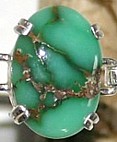
Treatment of Tourmaline Gems

 |
Treatment of Tourmaline Gems
|
 |
Tourmaline
is famous for the wide variety of colors that it occurs in – it is found in virtually
every shade of the rainbow. Because of its flexible borosilicate crystal structure, it can
accommodate a variety of both color center imperfections as well as color causing
transition metals, and minor differences in make up can greatly affect the color. While
most tourmaline gems in the jewelry trade are not treated, the percentage of these gems
being treated is increasing, especially among the pink and red toned stones. The processes
used include both heat and irradiation. Because of the wide variation in chemical
composition, treatment methods do not always work the same on stones of the same color
from different mines in different regions. Irradiation
generally has two major effects it can develop or intensify either red or yellow color. Depending on where the stone was mined, and what
color it was to begin with, will determine how it reacts to the radiation treatment. In general very pale pink green or blue darlings
who frequently become a deeper pink to read on a radiation; medium blue or green stones
may turn a deep purple; yellow stones may become an orange or peach color. However some deeper green stones actually turned
gray, as the red and green colors balance each other.
This red coloration is generally stable to about 400°C. The radiation treatments are generally done with
high energy electrons (sometimes called beta particles). Care must be taken during
irradiation to prevent excessive heat as the stones may be subject to cracking. Heating
removes the pink or red component of the coloration producing colorless stones from tanks
and Reds blues from some browns and purples and yellows from some orange tones. While the temperatures at which the coloration
disappears varies, virtually all such stones they colorize by about 700° centigrade. It
is long been known that some blue green and green term links can be significantly
lightened by heating about 650°C. Depending
on the oxidizing or reducing nature of the heat treatment used a variety of results have
been reported. Great care must be taken in
heat treating tourmaline both to avoid temperature shock and to make sure the treatments
do not exceed 700° centigrade. At a
temperature of about 725°C tourmaline loses essential water of crystallization, the
crystal becomes milky and destroyed. |
|
| Brownish
pink tourmaline stones, especially those from certain parts of Brazil, are treated by heat
to remove most of the coloration, and they radiated to produce a pure rose red. These gems
and some other pale tourmaline stones are among the most commonly treated types of
tourmaline. |
|
|
Want to know a little bit more about this crazy prospector guy? Well, here's a little bit more about me, and how I got into prospecting: Chris' Prospecting Story